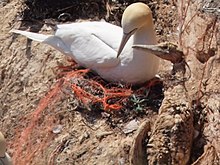Ghost net


Ghost nets are fishing nets that have been lost or that have been been left by fishermen. These nets then float around in the sea, or they end up attached to a rock or other structure. This poses a problem, because the nets continue working. Fish and other animals get caught, and then starve, or die of other causes. Since most nets use plastic, they take a long time to decay. In addition, the nets may release toxic substances while they decay.
Since 1997, there has been a large pile of plastic floating in the Pacific Ocean, hundreds of miles wide. People used to think it was made of pieces of plastic that had been thrown away by ordinary people, but in 2018 scientists found that it was mostly lost fishing nets and other fishing tools from large fishing boats.[1][2]
References[change | change source]
- ↑ Laura Parker (March 22, 2018). "The Great Pacific Garbage Patch Isn't What You Think it Is". National Geographic. Retrieved December 9, 2019.
- ↑ L. Lebreton, B. Slat, F. Ferrari, B. Sainte-Rose, J. Aitken, R. Marthouse, S. Hajbane, S. Cunsolo, A. Schwarz, A. Levivier, K. Noble, P. Debeljak, H. Maral, R. Schoeneich-Argent, R. Brambini, and J. Reisser (March 22, 2018). "Evidence that the Great Pacific Garbage Patch is rapidly accumulating plastic". Scientific Reports. Retrieved December 9, 2019.
{{cite web}}: CS1 maint: multiple names: authors list (link)
